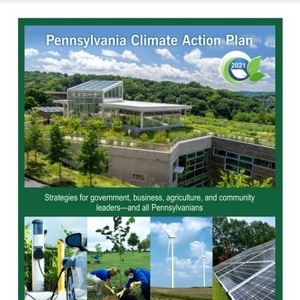Pennsylvania Climate Action Plan 2021 addresses biogas, LCFS

September 29, 2021
BY Erin Krueger
The implementation of a low carbon fuel standard (LCFS) and expanded production and use of biogas are among the strategies to reduce greenhouse gas (GHG) emissions discussed in the Pennsylvania Climate Action Plan 2021.
Pennsylvania Gov. Tom Wolf on Sept. 22 released the Pennsylvania Climate Action Plan 2021, which details a variety of actions that can help the state meet its 2025 and 2050 GHG reduction goals. The state in 2019 set the goal to achieve a 26 percent reduction in GHG emission by 2025 and an 80 percent reduction by 2050, when compared to a 2005 baseline.
Advertisement
Advertisement
The production and use of biogas features prominently in the 2021 action plan, which notes the state can produce biogas and renewable natural gas (RNG) from a variety of sources, including animal manure, food waste, landfill gas, water resources recovery facilities, agricultural residue, energy crops, forest residue and municipal solid waste.
The action plan also discusses the positive economic impacts of increased production and use of RNG. The average annual gross state product (GSP) and disposable personal income (DPI) impacts are expected to be $173.74 million and $163.11 million, respectively, according to the action plan. The RNG industry is also expected to foster employment for the construction of pipeline interconnections, resulting in the annual employment of 29,880 jobs.
Regarding the potential for an LCFS, the action plan indicates that such a program could expand on the ethanol and biodiesel requirements already in place in Pennsylvania and include zero-emissions vehicles.
Advertisement
Advertisement
The action plan estimates that an LCFS could achieve emissions reductions of 683,365 metric tons of carbon dioxide equivalent (MTCO2e) in 2025, and 1.58 million MTCO2e by 2040. The action plan projects the overall macroeconomic impacts of an LCFS would be negative, with the average annual GSP and DPI impacts expected to be -$483.60 million and -$135.33 million, respectively. The plan also forecasts that an LCFS would result in an average annual employment impact of -2,514 jobs. Those negative impacts, however, are not true of all fuels and technologies completing under an LCFS program. Increased production and use of renewable fuels and biofuels would be expected to be associated with lower energy costs and increased employment opportunities, if produced locally, according to the action plan.
A full copy of the Pennsylvania Climate Action Plan 2021 can be downloaded from the Pennsylvania Department of Environmental Protection website.
Related Stories
The USDA has announced it will delay opening the first quarterly grant application window for FY 2026 REAP funding. The agency cited both an application backlog and the need to disincentivize solar projects as reasons for the delay.
CoBank’s latest quarterly research report, released July 10, highlights current uncertainty around the implementation of three biofuel policies, RFS RVOs, small refinery exemptions (SREs) and the 45Z clean fuels production tax credit.
The U.S. EPA on July 8 hosted virtual public hearing to gather input on the agency’s recently released proposed rule to set 2026 and 2027 RFS RVOs. Members of the biofuel industry were among those to offer testimony during the event.
The U.S. exported 31,160.5 metric tons of biodiesel and biodiesel blends of B30 and greater in May, according to data released by the USDA Foreign Agricultural Service on July 3. Biodiesel imports were 2,226.2 metric tons for the month.
The USDA’s Risk Management Agency is implementing multiple changes to the Camelina pilot insurance program for the 2026 and succeeding crop years. The changes will expand coverage options and provide greater flexibility for producers.
Upcoming Events










